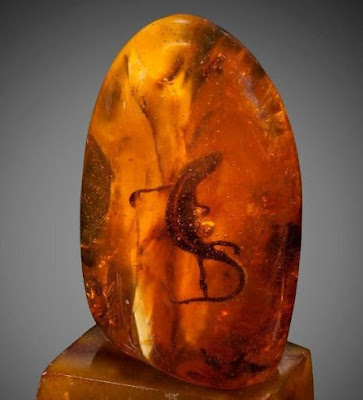Baltic Amber with Lizard Inclusion
LATEST NEWS
7:19 PM Thai Fisherman Finds Rare Orange Pearl Worth $330k
7:35 PM 635 Million-Year-Old Fossil Is the Oldest Known Land Fungus
7:29 PM Mineral Often Found on Mars Discovered Deep in Antarctic Ice
7:39 PM The Atlantic Ocean Is Getting Wider Every Year
6:55 PM Study Shows What Earth's Future Supercontinent Will Look Like
6:50 PM Gemologist Discovers Rock That Looks Like Cookie Monster
6:13 PM Dinosaur Unearthed in Argentina Could Be the World's Largest Land Animal Ever
7:12 PM Why Is Wave Rock Shaped Like a Wave?
7:39 PM Tiny, Mineral Grains Could Explain a Fundamental Tectonic Force
7:25 PM Stunning Heart-Shaped Amethyst Geode Discovered by Miners in Uruguay
7:19 PM Thai Fisherman Finds Rare Orange Pearl Worth $330k
The Eight Most Incredible Fossils Preserved In Amber
amber, Fossils 3:43 PM
The Eight Most Incredible Fossils Preserved In Amber
Even if fossils in amber are not useful for extracting dinosaur blood from for cloning purposes, despite what Jurassic Park may have you believe, they still preserve amazing snapshots of life millions of years ago. Amber is fossilized tree resin, a sticky, viscous substance secreted by plants in order to protect them from pests and predators. And because it is meant to protect a plant from predators, on occasion those organisms get stuck in the resin and frozen for millions of years, preserving fragile structures and unique instances of behavior paleontologists would have never seen otherwise. These are just nine example of the most incredible fossils found in amber in the last few years.
'Alien' insect in amber from 100 million years ago
'Alien' insect in amber from 100 million years ago
Introducing Aethiocarenus burmanicus. (image: George Poinar, Jr.)
Around 100 million years ago, an alien-looking insect with a bizarre head and long thin legs likely crawled around on trees in what is now Burma.
The insect is so strange that researchers say that it is not only a new species, but also belongs in its own new scientific order. Living in the time of the dinosaurs, the insect was tiny and wingless. Just two specimens of this new species exist, both of them preserved in Burmese amber.
Read about it here
Fluffy Dinosaur Feathers
Fluffy Dinosaur Feathers
Some 99 million years ago, a juvenile dinosaur got its feathery tail stuck in tree resin, a death trap for the small creature. But its misfortune is now giving scientists unique insight into feathered dinosaurs that prospered during the Cretaceous Period.
Researchers said on Thursday a chunk of amber - fossilized resin - spotted by a Chinese scientist in a market in Myitkyina, Myanmar, last year contained 1.4 inches (36 mm) of the tail of the dinosaur, complete with bones, flesh, skin and feathers. The dinosaur itself was no more than 6 inches (15 cm) long, about the size of a sparrow.
Read about it here.
Oldest arthropods ever to be preserved in amber
Image credit: Alexander Schmidt, Eugenio
The Dolomite Alps of northeastern Italy have revealed plenty of droplets of amber, each between two and six millimeters in length and not that remarkable-looking on the outside. Yet an international team of researchers led by Eugenio Ragazzi and Guido Roghi from the University of Padova and by Alexander Schmidt from the University of Göttingen discovered some of the oldest ever arthropods to be caught in tree resin.
There are two genera in the droplets, both gall mites. This in itself is surprising. Gall mites today predominantly feed on flowering plants. Yet these ancient mites date back to the Triassic, to before flowers had evolved. Source: Schmidt A.R. et al., Arthropods in amber from the Triassic Period. Proc Natl Acad Sci U S A. 2012 Sep ; 109(37):14796-801. doi: 10.1073/pnas.1208464109
Spider attacking a wasp
Spider attacking a wasp
Image credit: Dr. George Poinar Jr.
Trapped in a piece of amber, the juvenile spider appears to be on the cusp of devouring a male wasp that was caught in its web. Such a grisly scene between spider and prey has never before been found in the fossil record.
The amazing snapshot shows an event that occurred in the Early Cretaceous period, about 97 to 110 million years ago, in the Hukawng Valley of Myanmar, “almost certainly with dinosaurs wandering nearby,” as the press release about this discovery reports.
Read more at here.
Baltic Amber with Lizard Inclusion
Baltic Amber with Lizard Inclusion
Courtesy: Heritage Auctions
Baltic Amber is also referred to as succinite, and the European variety tends to have a lighter and more yellowish tone than other varieties, such as Amber specimens from the Dominican Republic. Of course, it is the curved "Lizard" preserved inside this incredible piece of Amber that makes this a beyond belief specimen. The creature is actually likely an amphibian of a salamander variety which should make it even more of a rarity.
As inclusions are typically only found in about ten percent of Amber specimens, any rare vertebrate like this is a paleontological treasure. A group of scientists in Russia performed numerous tests in the effort to authenticate this specimen. Determining specific taxonomic details of the creature are impossible to determine without further specialized testing. Examples like this will continue to be studied and tested.
Read more it



Comments
Post a Comment